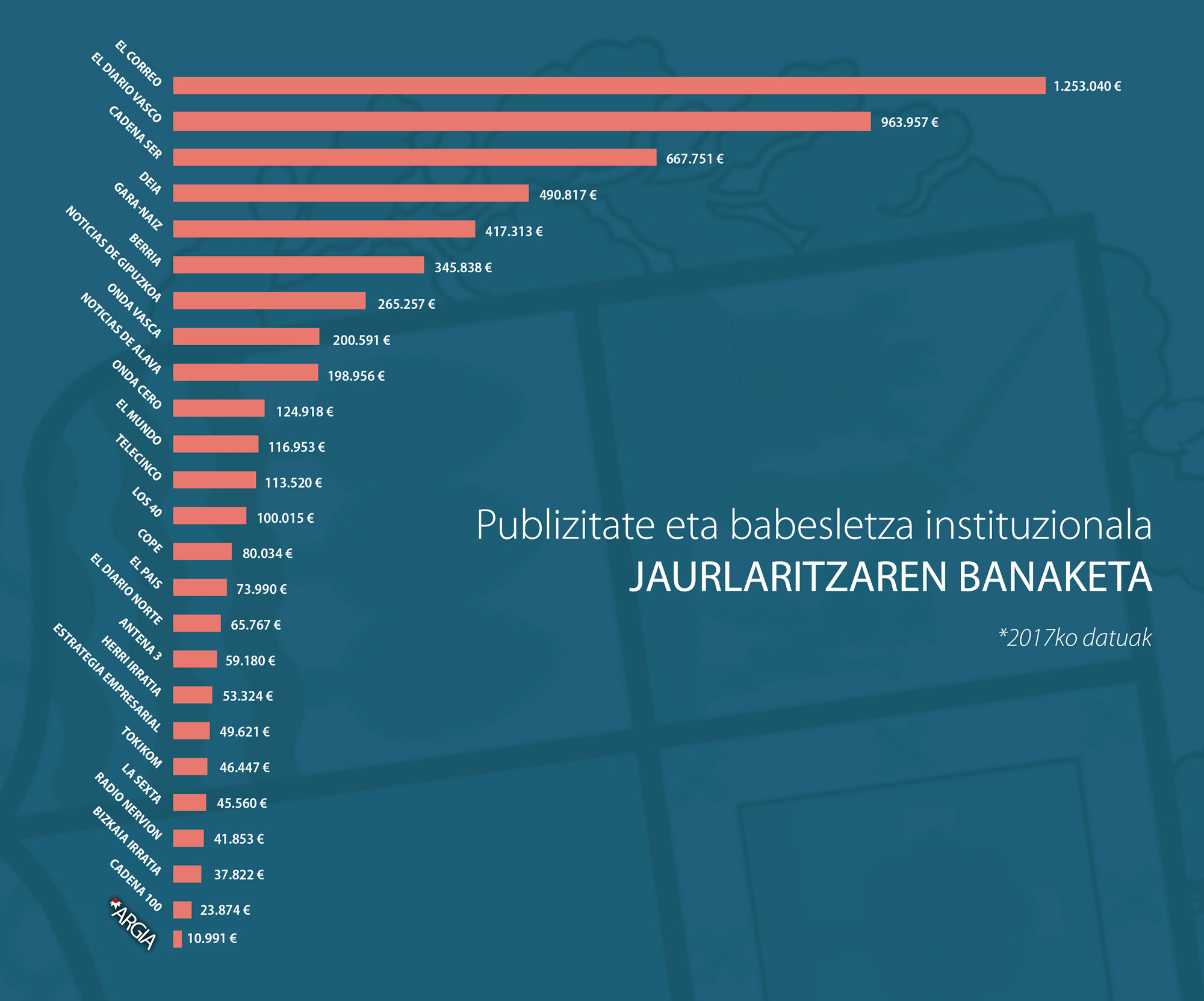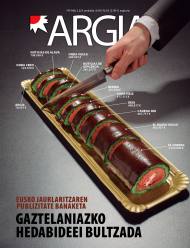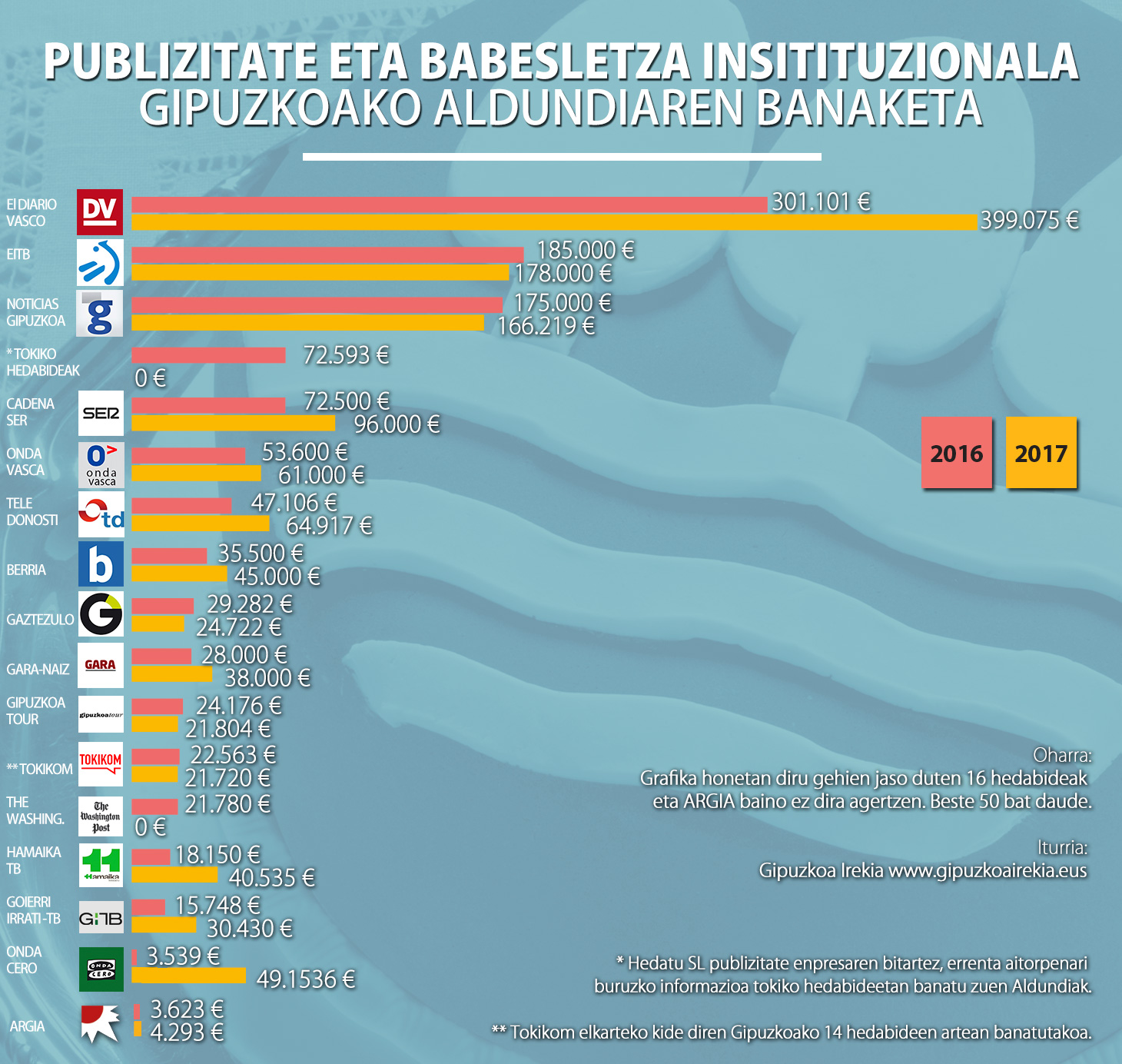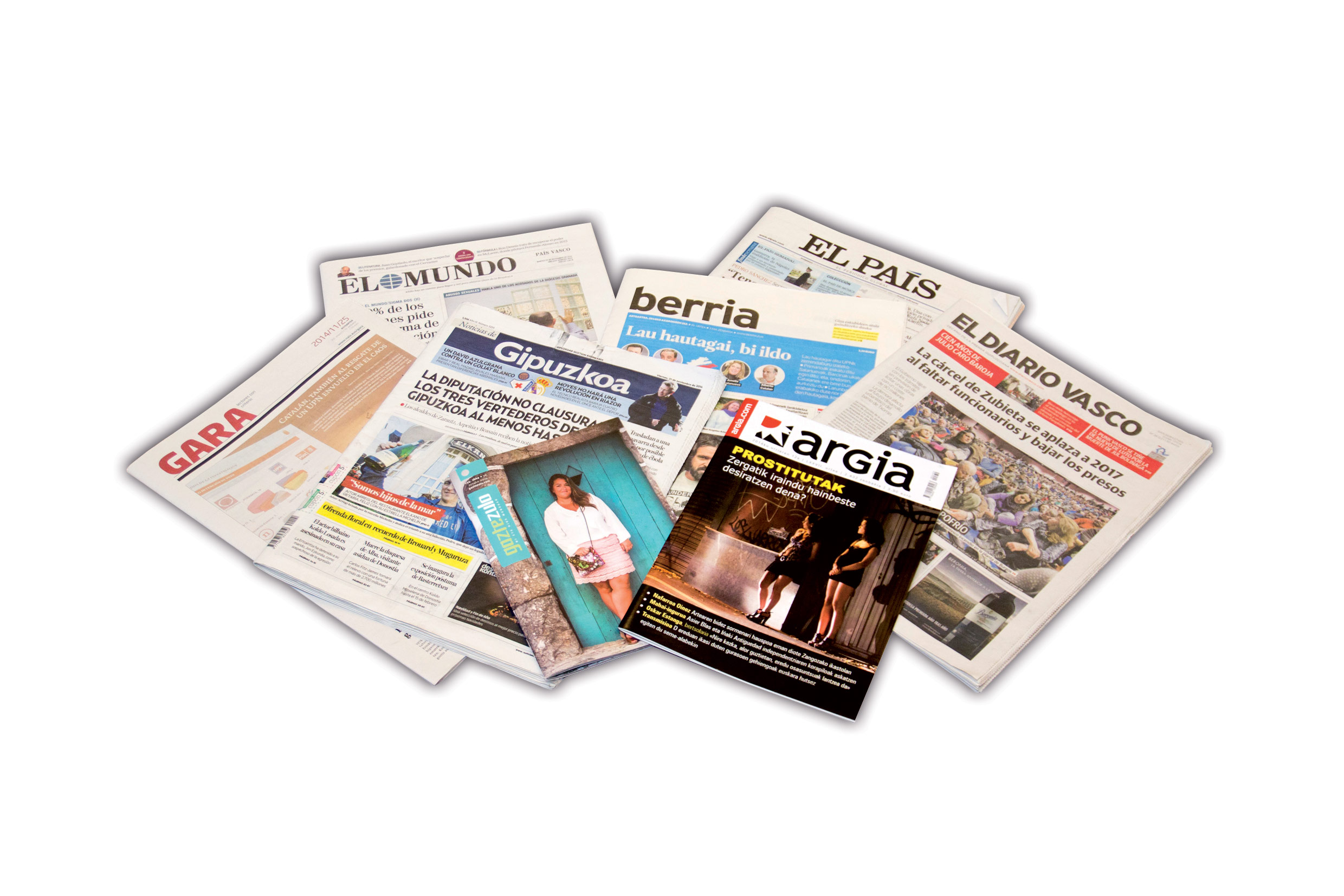What means of communication does the government’s publicity increase?
- Last year the Basque Government distributed EUR 8 million in the concepts of institutional advertising and content sponsorship among the media. Many conclusions can be drawn. One: the most publicly subsidised media belong to the Vocento group and the institutions donate millions of euros a year. Two: it can be concluded that distribution depends on political interests, because if media dissemination is taken as a criterion, it can be seen that some media groups close to power are exaggerated – and others deserve more. Three: The Basque Government allocated more money to the media in Basque than the entire subsidy granted to the media in Basque through advertising. Four: They left the LIGHT again. And five: thanks to the independent journalism that the community maintains, to keep putting those kinds of cakes on the table.

The public institutions allocate millions each year to the media. On the one hand, institutions make advertising contracts to advertise their campaigns in the media: see, to disseminate campaigns against income, flu vaccination, tourism promotion or sexual assaults. On the other hand, the institutions promote by sponsoring certain media projects they deem appropriate: Like the congress of the Diario Vasco “San Sebastián Gastronomika”. In this distribution, the Basque Government granted ARGIA EUR 10,991 in 2017. For example, after EITB's public medium, El Correo was the one that got the most money into public coffers: EUR 1,253,000 to the Diario Vasco and EUR 963,751 to the same group. The data is in the main graph by the media.
In this report the reader will find the data provided by the Basque Government. We have used two sources for this. On the one hand, the web Irekia, the portals of transparency and citizen participation of the Basque Government, the data offered and on the other hand, those that appear on the platform Public Procurement in the Basque Country. Although they are public data, being concise is not an easy task. Some contracts appear in one source, others are repeated in the other and in both.
Vocento-Cope (both formations reached a strategic agreement in 2012) is the one that received the most public money in 2017: Over EUR 2,300,000. The following were the means of the EITB public group: 2,000,000. The media included in the group Noticias, Deia, Noticias de Gipuzkoa, Noticias de Alava, Onda Vasca and Herri Irratia received in total more than 1,200,000 euros. Fourth Hurry Group: El País, Cadena Ser, Los 40 y Cadena Dial. These received EUR 846.160. The Gara newspaper received EUR 417,313, while the Berria newspaper received a total of EUR 345,838. The collective graph shows the numbers of the distribution.

In 2017, the Basque Government, with the exception of the bilingual public group EITB, allocated 92% of the amount for advertising and sponsorship to the media in Spanish or mainly in Spanish: EUR 5,749,974. The remaining 8% were allocated to Euskera: 496.819. In the Basque media as a whole, the only Basque national newspaper, Berria, collected two-thirds of that figure. Tokikom media received a total of EUR 46,447. It is clear that the Basque Government is in favour of the Spanish-language media. For example, only Deia, and also Cadena Ser, received the same money as all the media in Basque. The Diario Vasco adds two times more than the total in Euskera and El Correo almost three times more.
Distribution by political criteria
In 1993, Egin's report on this subject, entitled Dispositions of Nonsense, began with the following wording: “Although the public institutions pretend to cover what is unjustifiable by rhetoric, despite the fact that the other media in Euskal Herria is part of a tacit agreement, Egin is suffering an obvious economic drowning by the vascongested public bodies. Although the spokesmen of the Vitoria-Gasteiz Government say that the boycott is only at the head of the newspaper, the sincere explanation offered by the press officer of the Atutxa Department is more credible: ‘We don’t advertise because we don’t want.’ The LIGHT is also heard similarly. Finally, they said: “We all make political decisions, both us and you. The blame for this situation is not on one side and then everyone has to take steps to overcome this situation.”
The media in Basque, in addition to justifying subsidies up to the last cent, carry a false burden on the subsidized, while the Spanish media receive more public money through advertising.
Our response was clear: “We don’t use the concept of guilt. We call for a respectful relationship. The space of our magazine is a space that is well worth the price of advertising. And it is the respect that we ask, for placing public advertising in ARGIA, that no one tries to change our editorial line.”
According to data from the Office of Justification of Dissemination, known as OJD, based in Madrid, the sale of copies of El Diario Vasco between 2010 and 2017 has suffered a steady decline. A daily average of 71,948 units was sold in 2010, while 48,949 units were sold in 2017, according to the same source. With regard to the criterion of the distribution of public money, the authorities' usual response is the dissemination of the media. But the data do not match, neither in the distribution of advertising and sponsorship by the Basque Government, nor in that of the Representatives of Gipuzkoa or Álava. Proof of this is the amount generally received by the News Group. For example, News from Gipuzkoa (NG) received 265,257 euros and El Diario Vasco (DV) almost four times more. However, according to the 2017 data of the company CIES, DV readers are 10 times more than News readers. It is even more evident when compared to ARGIA: According to CIES data, although in the CAV the number of readers of Argia is twice that of ng, the Basque Government granted 25 times more money to the daily Noticias de Gipuzkoa.
As for radios, CIES estimated that the Chain 100 reached an average of 95,000 listeners in 2017, so it received 24.00 euros on average. According to the same source, Onda Vasca was heard by some 35,000 people, although, despite this, the Basque Government granted Onda Vasca 200,000 euros of public hearing. Data on Info7 Irratia are not available, but last year it received EUR 248. Therefore, if the money raised was proportional to the number of listeners, Info7 would have reached 43 listeners in 2017. And that's not the case.
ARGIA had a hearing in early 2018 of 52,000 readers at the CAV, according to CIES data. The following journals have received more money than ARGIA: Among the elderly, Karma, the Leisure Estuary or Economic Data, as well as Der Spiegel of Germany, almost double.
The Spanish media are the “subsidised media”
The media in Euskera have been accused, from time to time, of being “swollen with public money”, for the money they receive from the institutions in contrast to the public service they perform to promote the Euskera in the way of the normalization of the Euskera.

But the numbers say the opposite. In 2017, the Basque Government’s subsidy to the media in Euskera was €4,875,000. If we add to this the EUR 496,819 received in exchange for the publication of institutional advertising, the result is EUR 5,371,819. For its part, the Spanish media received public money through institutional advertising for an amount of 5,749,974 euros, to which must be added the high amount of money perceived by some Spanish media for writing several articles in Basque. And as the same trend is repeated in the advertising distributions of the three CAPV Members, the difference is even greater. Therefore, all the media receive public money, but the Basque media, in addition to having to justify almost everything to the last cent, have to take away from the false “burden of being subsidized”. On the contrary, in addition to the fact that the Spanish media receive more public money in general, the institutions are the main support for the economic viability of these media closer to power, which can lead them to a relationship of clientelism with power.
LIGHT again rejected
ARGIA has among its pages 100 years of living history of journalism in Basque and Basque Country. Our main economic livelihood is the thousands of people who make up our community. These citizens, like ARGIA, pay taxes here, but the advertising distribution of the Basque Government discriminates against them. In 2017, the Basque Government allocated EUR 8 million in advertising and sponsorship to 25 departments and sub-departments. Well, the ARGIA readers did not receive any information from the different public departments and sub-departments, including: Marinas of the Basque Country, Basque Railway Network, Ihobe, Department of the Environment, IVAP, Hacienda, Osalan, SPRI, Department of Tourism or Water Agency.
Only the call received as many publications as all the media in Basque Country added
The basis for the relationship between public advertising and the media should be information. Public institutions take advantage of the space, the work, the infrastructure, the distribution system and the credibility of the media so that the majority of citizens know the public initiatives paid with the money of all. Information is a public service paid with public money, but it has to be managed and cared for with great caution, because the history of the power-conditioned media is as long as dark. That is why, in institutional advertising, clear criteria, parity and transparency are the basic pillars when the use of public money is at stake.
Contact with public institutions, whether through subsidies, advertising or sponsorship, should not affect the press and freedom of opinion, which would reduce the right to information for citizens. It is therefore worrying that, through an unfair distribution of public advertising and sponsorship, the Basque Government will condition the media ecosystem.
There is still a long way to go in terms of transparency and clarification of the criteria relating to the distribution of advertising. But these are issues that can be easily resolved, whether there is a will on the part of public institutions and whether the media provide close monitoring of the use of public money to citizens.
Promoting diversity of opinion or perpetuating the status quo
The next chapter is published in the report we wrote last February on the advertising distribution of the Provincial Council of Gipuzkoa. Almost a year later, the questions are still on the table.
Advertising is an indispensable economic income for the survival of many media, and above all, sponsorship and public advertising. The economic relationship between political power and private companies is an area that must be monitored with great caution in any democracy. And in the case of the media that have to guarantee freedom of information, even more so. Because journalism is a factor that can question its independence, economic and political, necessary for it to be a journalism.
“If you distribute money arbitrarily you are buying wills, you are harming the right to information. Freedom of expression is seriously impaired if the press is not related to freedom; and freedom of the press cannot be fully developed without fair rules.” Eldiario.es Ignacio Escorial, director of the media, talks about the media landscape in the Spanish state at a conference organized by Amnesty International. “We have a plural press, almost all Spaniards can find a press that shares their opinions and points of view; but what we do not have is a fair playing field for the press,” he said, referring to the control of information from political and economic actors. In particular, this sentence referred to institutional advertising, to the distribution of public money with arbitrary and opaque criteria.
In order to receive public money, must we have at the same level the media owned by the multinationals and the media owned by the workers, such as ARGIA?
Without prejudice to the problems of calculation of scope, the conversion of scope into the main criterion of distribution is an effective means to perpetuate the status quo of the media, as well as the hegemony of Castilian to the detriment of the Basque Country. By not considering the work done by some media on social networks, they benefit from many means and harm others.
Should the media owned by the multinationals (in the case of Vocento, for example, BBVA is the majority shareholder) and the working-owned media such as ARGIA be at the same level? Competition in itself is unbalanced, between a medium backed by a large bank and one that keeps up with its resources. The first of these is guaranteed daily dismissal, if investors consider it appropriate that this means of communication be available to their interests, even if they lose their money. The second, on the other hand, must get funding for each issue it publishes. If the institutions have to protect the plurality of information, what is the point of the current advertising policy?
Tourism
Zein dira publizitate bidez diru publiko gehien jasotzen duten hedabideak? Arabako Aldundiak publizitatea zein mediotan inbertitzen duen aztertu du Hala Bedik. El Correo de Álava da jaun eta jabe, publizitatearen %31,8a jasotzen baitu; nagusiki euskaraz aritzen diren... [+]
Espainiako Gardentasun Kontseiluak zortzi ministeriori iragarkien datuak publiko egin behar dituztela exijitu ostean, salaketa jarri dute Auzitegi Nazionalean erabakia ez betetzeko.
Hedabide euskaldunak biltzen dituen Hekimen elkarteak bilera eskatu dio Gipuzkoako Foru Aldundiari, erakunde horrek iragarritako publizitate instituzionalaren beherakada aztertzeko. 2015eko aurrekontuarekin alderatuta, erdira jaitsiko du euskarazko hedabideetako publizitatea... [+]






















